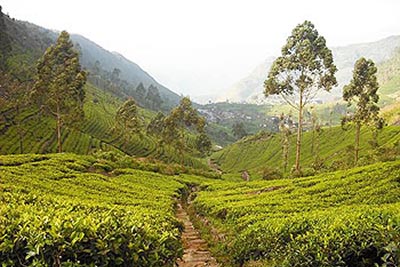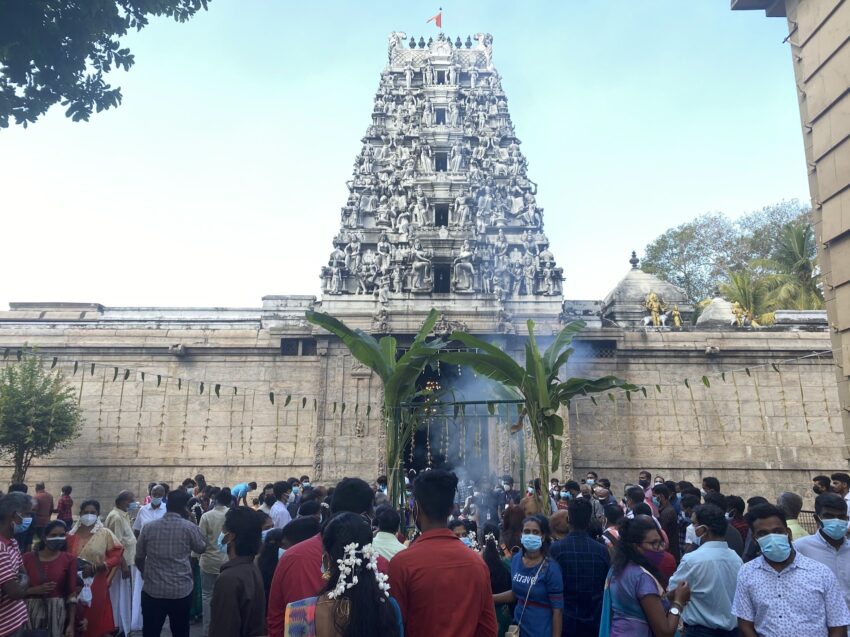
The national holiday Pongal Thai in Colombo, and in Kandy
By Annie Chen
GoNOMAD Senior Writer
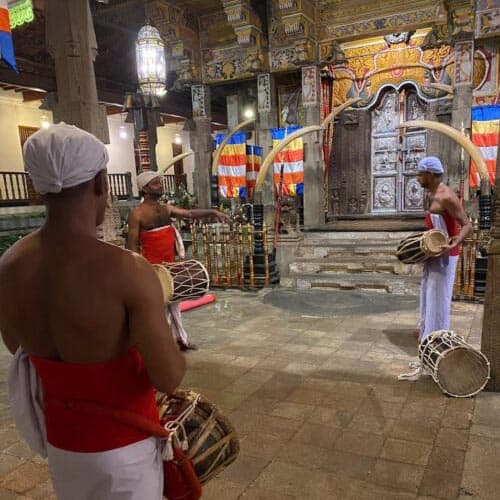
Kandy is often cited as the heart of Sri Lanka, not only physically being central to the teardrop-shaped island country, but also as a cultural capital and ancient center of the nation.
The most talked-about sight in Kandy is the Sacred Tooth Temple, also known as Sri Dalada Maligawa.
A UNESCO World Heritage site of national importance, the Temple of the Tooth houses the relic of the Buddha’s tooth which had been historically in the possession of top rulers and governing parties for the country.
Former Monarchy
The temple is just one of many structures in the royal palace complex of the former monarchy, the Kingdom of Kandy which ruled from the 15th to the 19th century. Because the compound is enormous, there are strict guidelines that visitors have to abide by to enter and visit the temple.
The Sacred Tooth is open for three viewing session windows – pujas – throughout the day: 5:30am – 6:45am, 9:30am – 11:45am and 6:30pm – 8pm. In the evening time slot, I encountered a constant stream of devoted visitors, almost all dressed exclusively in white, pouring towards the main entrance by Kandy Lake.
Vendors by the entrance sell floral plates and scented offerings, calling out competing prices and shouting over the hum of bees. The locals go through a metal detector in the lake-side entrance, but foreigners go up a separate flight of stairs to a different entrance.
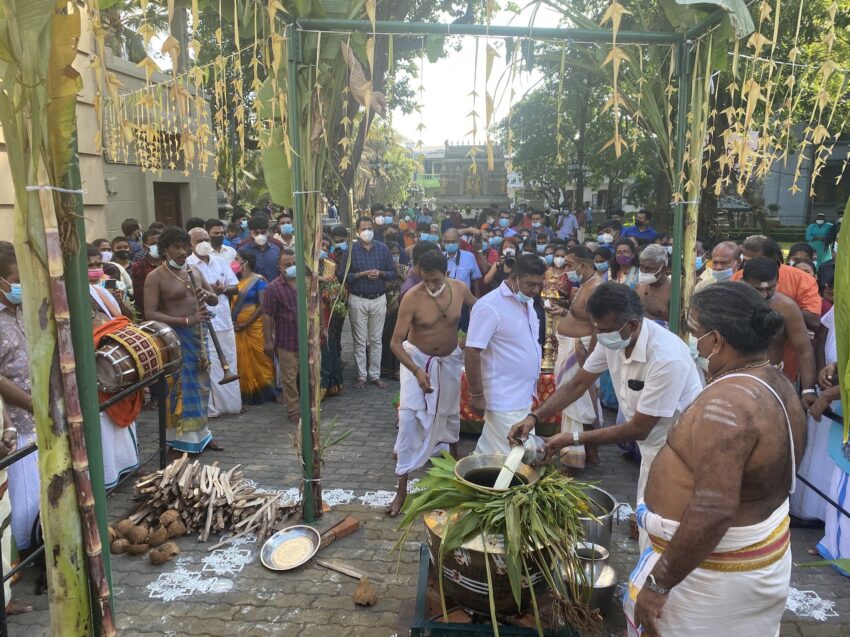
Female security guards are additionally posted to specifically reinforce the dress code. My dress was shin-length but the two slits on the sides had to be tied together to fully cover my knees.
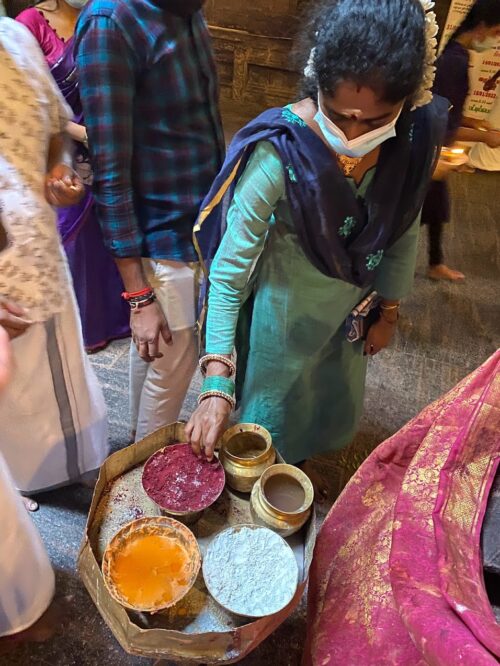
Just after the metal detectors, another official assisted foreign visitors with the automated ticketing machine. The entrance fee is 2,000 LKR ($10 USD) except for residents of the eight South Asian Association for Regional Cooperation (SAARC) countries – Afghanistan, Bangladesh, Bhutan, India, the Maldives, Nepal, Pakistan, and Sri Lanka- who pay 1,500 LKR (about $7.50 USD).
No Shoes Allowed
A neighboring booth enforces an additional rule; no shoes are permitted anywhere inside. Luckily, the storage is free and manned until closing hours.
The main temple is just beyond, where drumming was already signaling the beginning of the viewing session. I rushed in to find a mixed crowd watching three drummers on the ground floor of the temple entrance. However, the flow of locals in white gowns was progressing upstairs and we soon realized that was where the actual tooth was.
The second story of the gold-roofed shrine was the definition of organized chaos. A long, winding line of dedicated followers was roped off lining the side of the room. It moved quickly, though, and in a matter of minutes, I was near the front.
A small, gated-off private chamber directly in front of the viewing window was reserved for special guests; I glimpsed five individuals bent over in prayer on the ground.
A Peek at the Golden Tooth in Kandy
Then it was my turn at the window, where I glimpsed the golden encased tooth underneath layers of protective casings. The monks kept people from lingering too long, though, and no photos were allowed, so I followed the line back out into the open room.
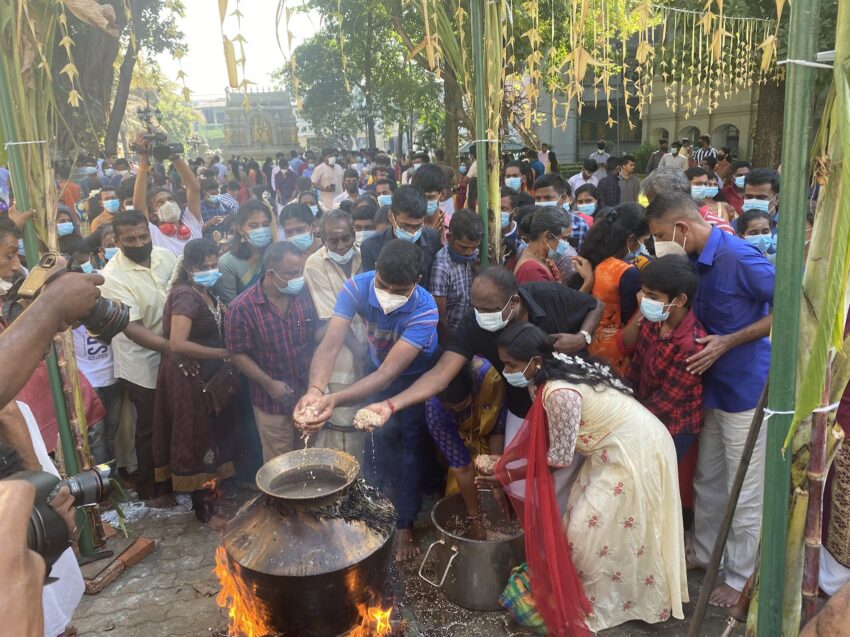
In the center of the rectangular room, a long table was overflowing with flower offerings of different varieties and sizes. Lines of people had their eyes closed in meditative prayer, hands pressed together.
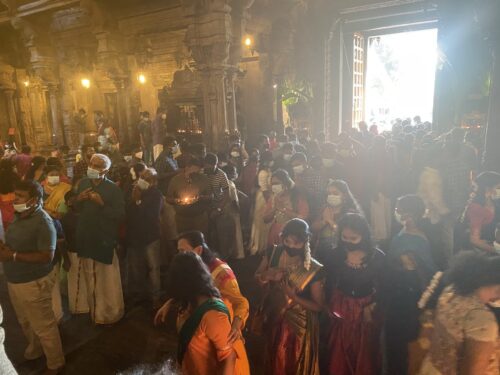
Back downstairs, a side staircase leads visitors up to the two-story museum. Glass cases and security guards protect a variety of artifacts from Kandyan history. Ola leaf books, thin rectangular sheets bound together delicately, contain the Buddha’s preachings.
Votives in the shape of lotuses, which symbolize the rebirth of Buddha, sit in a row by size. Decorative tassels for elephant ears during processions made of the fur of yak tail hang down from nails. Elephant tusks are intricately carved with minuscule Buddha figures.
Other structures are smaller or more open-air in comparison. One viewing room serves as an image house, with a short line to enter and pay tribute to a sitting Buddha statue. Semi-circular moonstones are found at the foot of the staircases leading to sacred sites, with four layers of animals representing the four stages of life.
Another prayer room had colorful images on the walls detailing the history of the 1818 Rebellion where the Kandyans rose up against their British colonizing rulers. During the squirmish, the tooth was hidden away in a forest, only to re-emerge years later. An all-glass greenhouse type of space stands in the garden heated up with all the lit candles on the long rows of metal stands.
Painted ceilings in the covered walkways connecting different units of the palace complex depict parts of the Kandyan kingdom’s history.
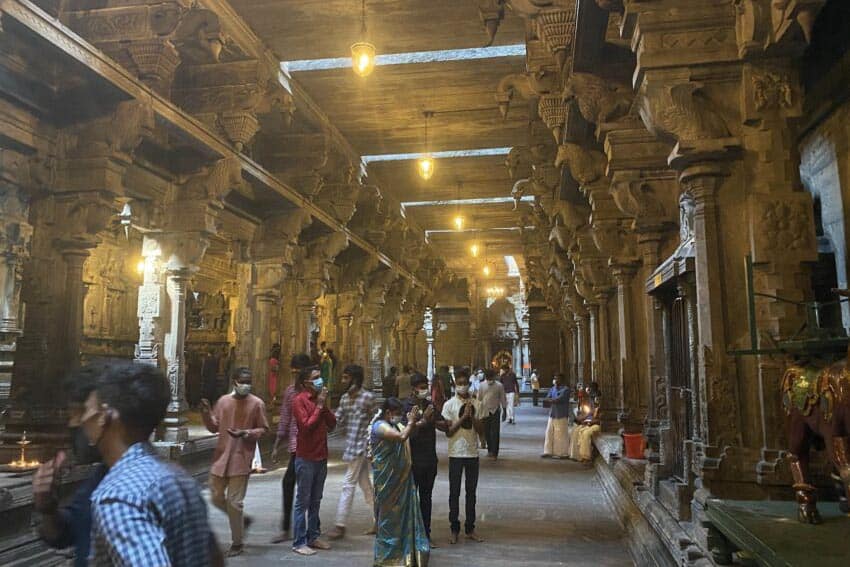
As I headed towards the exit, I stopped by the main bus station in the center of town to check on times for the ride back to Colombo. The 5-hour ride was, as many people had warned me, fairly direct but full of traffic the closer we got to the capital. My bags were wedged among canvas bags behind the bus driver, filled with goods being delivered for businesses, and a sea of red, green and blue tuk-tuk canvas tops swarmed in front and around the comically juxtaposed, enormously large buses.
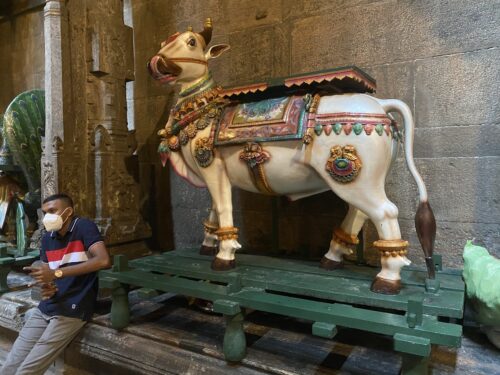
In Time for Tamil Thai Pongal Day
It was an extra effort to make it back to Colombo by the next morning but well worth it because I knew it was a national holiday, Tamil Thai Pongal Day.
Although this harvest festival is most commonly held over multiple days, the largest kick-off is usually the first day. Celebrated by the Tamil people of India and Sri Lanka, Thai Pongal is said to be non-religious and held on the first day of the month of “Thai”, which is generally mid-January.
I waved down a tuk-tuk with a fixed meter and showed him a Google Maps location to one of the largest Hindu temples in Colombo, Sri Ponnambalawaneswarar Devastanam Kovil.
Although it was still early, by the time we pulled up, I saw that the storage room for shoes at the entrance had already reached capacity and extra men were keeping guard over lined up pairs of shoes on the street outside with scrawled numbers on scraps of paper.
As I walked through the parking lot, many families and children were also just arriving. We rounded the corner towards the interior courtyard of the temple and found hundreds of locals already milling about. A small faucet along the wall was crowded with people washing their feet since everyone was barefoot.
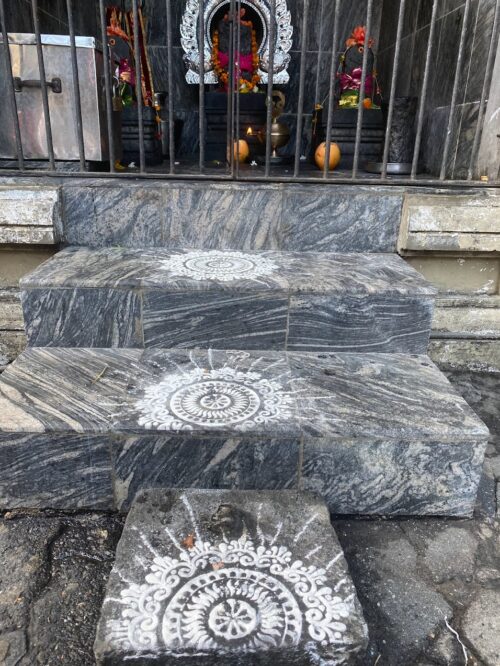
Couples and family friends socialized on the grassy area, and strings of decorative coconut leaves were folded into triangular shapes and dangling from garlands hanging over the central space.
Elaborate Designs on the Ground
I stepped carefully, taking in all the sights but also mindful of where I walked. On the ground were decorative art formations called kolam which is traditionally made of rice flour and in more contemporary times, mixed with other chalk-like colored powders.
Tamil women take years of practice to hone this skill of creating elaborate designs with their fingertips, which is generally done only on special occasions.
At the center of the courtyard was a small offering on a table facing a makeshift fire pit of metal and bricks with wooden logs underneath, directly in front of the main temple entrance. Three metal traffic barricades kept the people at bay from the ritual.
Two priests, bare-chested with loose, white pants that had gold and blue trimmings, dragged out a large copper cauldron that had white markings drawn on it, and positioned it onto the firepit as other priests rang bells and a blaring wind instrument, resembling a cross between a horn and a clarinet, accompanied a drummer. The rim of the pot also had coconut leaves tied to it decoratively.
Setting Fire to the Logs
The crowd grew as one priest set fire to the logs, and another emerged with a pot of water. He and the others took turns pouring cups of water into the cauldron.
As the priests set about stoking the fire, a local photojournalist on my left tapped my elbow, pointing at the door to the temple. I realized the fumes from the cauldron’s smoke were supposed to have a cleared pathway directly into the temple’s entrance, and I edged over a bit.
Lighter fluid was squirted into the fire pit, and the flames rose up to engulf the leaves around the rim of the cauldron. Three more priests came out with buckets of milk, and poured them into the cauldron, taking turns again. The spectators had formed an informal line for the final step; adding rice to an overflowing pot of milk – also known as pongal, giving the holiday its name – is a traditional symbol for prosperity and abundance into the new year.

The locals scooped grains of rice with their two hands out of a large canvas sack, tapping their foreheads and whispering prayers into their hands before gently pouring the rice into the pot.
Red Dots for Worshippers
I turned around to head inside the main temple. Noting what the locals were doing, I took care not to step on the threshold, passing carefully over it.
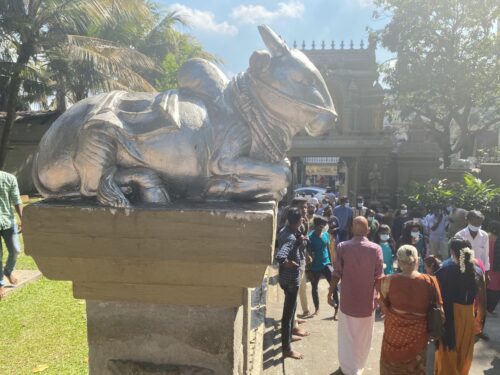
Near the entrance was a stand with variously colored powders in little dishes for worshippers to dot their foreheads; the red was most popular and is a combination of kumkuma and turmeric.
In contrast with the two eyes which look outwards from one’s face, it is said that the dots, or bindis, serve like a third eye that looks inwards towards God and symbolizes piety.
On the other side of the main entrance was a booth selling tickets for the oil lamps on a table next to it. The small clay lamps, or vilakkus, came in different sizes but all had candle wicks, tediously braided with string and cut into identical lengths. A large vat of yellowish oil sat at the edge of the table with two long scooping spoons to fill the oil lamps.
Along the edges of the temple, smaller shrines were dedicated to various gods with different opening times for each. The lines of locals waited patiently for the priests to unlock small, metal gates to where their offerings could be left in tribute.
The central section of the temple, the moolasthanam, acts as the center of the universe. It’s several feet off the ground, and a cordoned-off strip ran down the middle towards the primary shrine where Surya, the Sun God, and Shiva, the deity of death and time, sat.
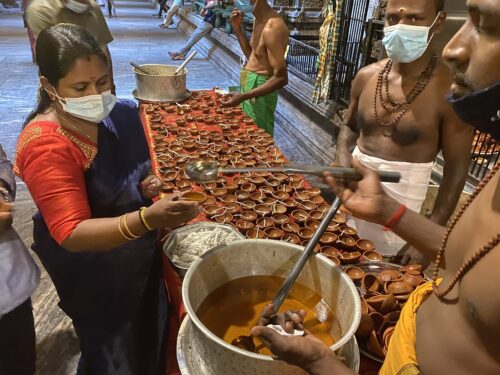
Temple-goers were scattered among the columns on either side of the strip, some sitting on the ground, taking in the shade and incense-filled haze.
A larger crowd of Sri Lankans stood along the metal barriers for the priests to come by, holding up holy flames to bring blessings to all.
An elaborate kolam ran along the length of the central strip, welcoming in the new year. Young girls wore white scented flowers in their hair, accenting their bright purple and blue saris.
As I looked over the temple’s calendar of events by the exit, one devotee nearby explained that the next day, a cow would be brought in, decorated, and washed as part of their worship.
With firecrackers going off in the distance, I could easily imagine it – the jingle of the bells on its ears, the rainbow sea of traditional gowns, excited children with bindis on their foreheads ready to usher in the new year.
- The Interesting Bamileke Region of Cameroon - September 11, 2023
- Mombasa, Kenya: Crocs, Snakes and Empowered Artists - April 9, 2023
- Cameroon’s Douala-Edéa National Park - February 11, 2023



